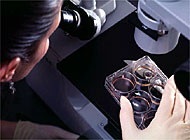Virus kills cancer tumours in mice

Scientists in Switzerland have discovered that a harmless human virus wipes out tumours in mice by prompting cancer cells to self-destruct.
The research at the Swiss Institute for Experimental Cancer Research (ISREC) in Epalinges sheds light on an existing phenomenon – why some viruses damage cancer cells but spare normal, healthy cells.
The research involves a gene called p53 which normally suppresses tumours. In many cancer patients, the p53 gene is defective. The virus exploits that flaw.
“When the virus enters a cancer cell with an altered p53 gene, the cell is tricked into imagining that its DNA is damaged,” Professor Peter Beard from ISREC told swissinfo. “As it tries to rid itself of the damage, it ends up self-destructing.”
Targets mutant cells
However, when the virus goes into a healthy cell with working p53, the cell simply stops dividing until the virus has degraded.
The p53 gene mutation, which the virus exploits, is present in about half of all human cancers. Drugs, which target p53 mutant cells are in great demand as they offer the prospect of curing many cancer and tumour types without the harmful side effects of treatments such as radiation or chemotherapy.
Cancer specialists said the new approach appeared to have potential but only time would tell if it could fulfil its promise.
Researcher, Arnold J. Levine, co-discover of the p53 gene in 1979 and president of Rockefeller University in New York, said it was a long way off from ever being tried in humans.
“One problem is that this virus doesn’t replicate by itself very well,” said Beard. “It needs a helper virus to replicate. To be effective it must infect every tumour cell separately.”
Question marks
Another question is whether these viruses can be grown in sufficient quantity to make human clinical testing possible.
Beard said his team hopes to pinpoint the precise feature on the virus DNA which sends cancer cells to their death. If they can do that, it might be possible to specially engineer the virus or even develop a drug mimicking its effects.
The ISREC team first made their observation by accident when they were trying to grow the virus in different kinds of cells. In later experiments, they confirmed that tumours in mice shrank when they were given the virus.
ISREC, the Swiss centre for basic research on cancer, was founded in Lausanne in 1964. A non-profit organisation, it is supported principally by funds from the Swiss government as well as by project grants from the Swiss National Science Foundation and the Swiss Cancer League. The centre has a staff of 180 people.
The findings were reported in the journal Nature.
by Vincent Landon

In compliance with the JTI standards
More: SWI swissinfo.ch certified by the Journalism Trust Initiative








You can find an overview of ongoing debates with our journalists here . Please join us!
If you want to start a conversation about a topic raised in this article or want to report factual errors, email us at english@swissinfo.ch.